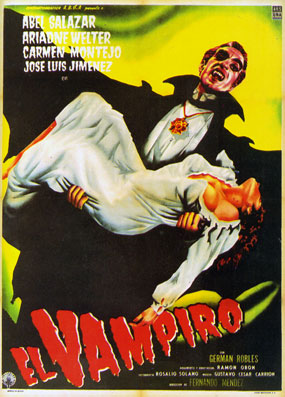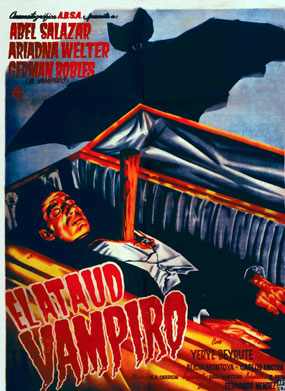| Reviews & Columns |
|
Reviews DVD TV on DVD Blu-ray 4K UHD International DVDs In Theaters Reviews by Studio Video Games Features Collector Series DVDs Easter Egg Database Interviews DVD Talk Radio Feature Articles Columns Anime Talk DVD Savant Horror DVDs The M.O.D. Squad Art House HD Talk Silent DVD
|
DVD Talk Forum |
|
|
| Resources |
|
DVD Price Search Customer Service #'s RCE Info Links |
|
Columns
|
|
|
Vampire Collection: El Vampiro & El Ataud del Vampiro, The
The Vampire predates the release of Hammer's seminal Dracula / Horror of Dracula by almost eight months, yet in many ways it anticipates the Christopher Lee-style vampire that broke from of the Bela Lugosi mold. (Though some may find lineage with the Dracula played in several '40s films by John Carradine.) Count Karol de Lavud, alias Mr. Duval (German Robles), is much more physical like Lee than Lugosi, and like Lee is dashingly handsome and erudite.
The picture successfully integrates two disparate elements: the German Expressionist influence of the Universal films with its rural Mexican setting. The Vampire, though not its sequel, also set its story in the same kind of timeless Never Never Land of the Universal films. Though its leads are clearly contemporary, the area around the Hacienda where most of the action takes place could be late-19th century Mexico, and the Count rides around in an even older horse-drawn carriage, though none of this seems particularly strange.
The story has Marta Gonzales (Ariadna Welter, sister of Linda Christian) rushing home to the family's palatial hacienda where her beloved Aunt Maria (Alicia Montoya) lies gravely ill. On the way she meets Dr. Enrique (Abel Salazar, also the film's producer); he's been invited by Maria's brother, Emilio (Jose Luis Jimenez), who's concerned about his sister's hallucinatory claims that the estate is being overrun with vampirism.
The pair arrives to find that Aunt Maria has died and was entombed only the day before. Meanwhile, it becomes clear that Maria's other aunt, Eloisa (Carmen Motejo) is herself a vampire, and that her undead status has washed away the years and restored her youthful beauty. Callously she presses Marta to sell the property to mysterious stranger Duval (Robles), actually the resurrected Hungarian Count Lavud. (His alias adapts the oft-used ruse of Dracula, who in the movies frequently reverses the letters of his name to become "Alucard."
The Vampire doesn't particularly add to the genre so much as refine it. (Mild Spoilers) Other than simply being a very well-made, atmospheric vampire movie its major contribution to the genre is the addition of poor Aunt Maria. Entombed with a large crucifix she later turns up as an emaciated, ghostly figure - still holding that large crucifix - silently warning Marta of the danger all around them. These scenes are still pretty creepy a half-century later, and actress Montoya, in fact only 36 years old at the time, visually is just right as is her earnestly panicky performance.
Overall, the film's main asset is Fernando Mendez's inventive direction and Rosalio Solano's superbly atmospheric cinematography, with extreme, noirish shadows recalling the best of John Alton. (And, like Lugosi's Dracula, little spots on the actor's eyes add an eerie effect.) The ability of Lavud and Eloisa to materialize in and out of scenes via simple jump cuts isn't particularly original (and it betrays the accepted limitations of vampirism), but Lavuds transformations into bat form is expertly edited, despite some highly visible wireworks used to show the creature in flight. Also good is the strong emphasis on how the vampires' reflections don't appear in mirrors, an attribute usually underplayed or ignored all together in most other films of this type.
The Vampire's Coffin isn't nearly as ambitious, playing much like a Universal horror film from that studio's "second cycle," with a greater emphasis on blood and thunder action in place of subtle atmosphere, but it's still a lot of fun in its own way and offers yet more great cinematography.
Recuperating at a peculiarly deserted hospital under Dr. Enrique's care, Marta is nearly fully recovered from her terrifying ordeal, and ready to resume her career as a dancer in a big variety stage show. Meanwhile, one of Enrique's colleagues, Dr. Marion (Carlos Ancira) foolishly (and without a lot of motivation) steals Lavud's coffin with the help of wild-eyed grave robber Manson (Yerye Beirute) to study it. (In a mirror, the perfectly preserved corpse appears only as a well-dressed skeleton.) Removing the massive stake from Lavud's body, Manson accidentally revives the Count, who immediately makes the thug his servant. Lavud sets up shop in the basement of a nearby wax museum, quickly learns of Marta's whereabouts, and becomes determined to make her his bride.
The Vampire's Coffin has a greater emphasis on humor and action, with Enrique less the roguish leading man of The Vampire and more a bumbling comic relief type bordering on Bob Hope, a role apparently more in line with the Salazar's usual screen persona. There's also the obvious addition of elements lifted from House of Wax and Phantom of the Opera, the latter with Maria's career on the line ("C'mon kids! Three minutes till curtain time!") while Lavud stalks her from the wings. (Welter is clearly no dancer, however, with a lack of grace that borders on the absurd.)
That said, the film has its share of terrific set pieces, particularly when Lavud chases a dancer (and coded prostitute?) through the empty city streets, with the vampire's enormous shadow threatening to swallow her whole.
Video & Audio
The first reel or two of The Vampire shows a lot of wear that CasaNegra and Panik House try to hide with a lot of digital clean-up that's more distracting than effective, but the rest of that film looks fairly good and all of The Vampire's Coffin is pristine, with superb sharpness and contrast. While both films are presented full frame, The Vampire may have been shot with widescreen framing in mind. At 1.77:1 the image is only a little bit snug here and there, suggesting perhaps an OAR of 1.66:1. The Vampire's Coffin definitely was released in widescreen, however, probably 1.85:1, and compositions are vastly improved reformatted/zoomed-in on widescreen TVs. (Thankfully, the transfer is so good that the loss of clarity is minimal, though one has to play the English dubbed version this way as the subtitles get cropped off in the process.) Both films are presented in both their original Spanish with English subtitles and in the poorly-dubbed English-language versions produced ten years later, the former with optional Spanish subtitles. Menu screens are available in both English and Spanish.
Extra Features
The Vampire also includes a commentary track by Mexican fantasy film fan Robert Cotter, author of The Mexican Masked Wrestler & Monster Filmography. His delivery tends to be rather monotone but the information he presents is valuable.
Also included is a great photo essay by David Wilt that features lots of colorful Mexican posters and lobby cards, Fear a la Mexicana! Mexican Horror Cinema, 1953 to 1965. Supplements continue with informative cast biographies, extensive Stills & Poster Galleries, lurid original radio spots for the mid-1960s U.S. theatrical releases that show how badly these films were managed by K. Gordon Murray's Trans-International Films, and a reprint of Abel Salazar's 1995 obituary in The Boston Globe.
The complete French photo-novel of The Vampire's Coffin circa 1976 appears as a DVD-ROM feature, while the packaging includes a Lotteria Game Card, whatever that is.
Parting Thoughts
This is a must-have for all serious horror film fans: two extremely well-made horror films from South of the Border deserving the first-class treatment CasaNegra and Panik House give it. Highly Recommended.
Film historian Stuart Galbraith IV's most recent essays appear in Criterion's new three-disc Seven Samurai DVD and BCI Eclipse's The Quiet Duel.
|
| Popular Reviews |
| Sponsored Links |
|
|
| Sponsored Links |
|
|
| Release List | Reviews | Shop | Newsletter | Forum | DVD Giveaways | Blu-Ray | Advertise |
|
Copyright 2024 DVDTalk.com All Rights Reserved. Legal Info, Privacy Policy, Terms of Use,
Manage Preferences,
Your Privacy Choices | |||||||
















